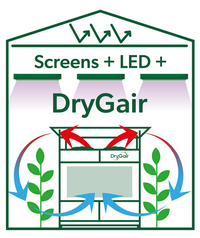Energy is one of the biggest challenges for the greenhouse sector these days. Sadly, rising prices have driven many growers to cut back on their operations this winter while others seek ways to reduce their energy costs.
Eef Zwinkels, technical account manager at Royal Brinkman, says one of the simplest ways to reduce energy costs is by using dehumidifiers, such as DryGair. The topic of dehumidification has been a hot one in recent years. Many growers have already installed these humidity control systems and report significant energy savings.

But can dehumidifiers really save energy?
“Absolutely.” Says Zwinkels. “One of the biggest energy expenses in a greenhouse is ventilation. Especially during the winter or at night when it’s cold outside. When you open the vents and windows, you let all the heat out and allow cold air inside. That way, you must keep heating.”
“When you keep the greenhouse completely closed, you recover all of this energy. That makes a huge difference in energy usage.”
That sounds great. But how do dehumidifiers affect this?
“That’s a good question and one that I’m asked often.” Zwinkels continues, “The main reason to open windows and vents is to release moisture. The plants are always evaporating water, so if you keep the greenhouse closed, you’ll have very high humidity. Of course, that leads to diseases, molds, and overall less efficient crop growth and development.”
“So what’s the alternative?” Eef asks and replies, “to control humidity from inside the greenhouse.”
“Using a dehumidification system, such as DryGair, allows you to remove moisture without opening the greenhouse. It provides complete control over humidity, just like you would control temperature or lighting.”

Is it really that simple?
“It’s almost too simple to believe,” Zwinkels says. “For many, it seems too good to be true. That’s because they’re used to operating in a certain way.”
Dehumidifiers are relatively new in horticulture. For example, DryGair, the leading dehumidifier manufacturer in the sector, was only formed in 2010.
Eef continues, “It sometimes takes time to realize how to incorporate new technological advancements. It requires you to rethink the entire way you operate the greenhouse. That’s why we call it ‘A New Way to Grow.’ It’s not just putting a dehumidifier in the greenhouse that saves energy, and it’s changing the way the greenhouse operates.”
“That’s the most important thing. Once you have your dehumidifiers, you need to operate them correctly. If you continue to ventilate when it’s cold or humid outside, you won’t get the greatest benefits.”
How do you operate the greenhouse to get the most energy savings? Eef answers, “It’s based on a very simple principle. If the weather outside is cold, damp, rainy, etc., ventilation won’t be efficient. In these cases, you should completely close the greenhouse, preferably with thermal screens, to keep as much of the heat inside. Now, turn on your DryGair system, and let it take care of the moisture. You can improve your savings even more if you add efficient grow lights. This way, you don’t even need to open the screen to let light in, and you can operate in a completely controlled environment. This not only saves energy, but improves crop growth, helps with CO2 retention in the greenhouse, and even produces reusable water.”
Eef answers, “It’s based on a very simple principle. If the weather outside is cold, damp, rainy, etc., ventilation won’t be efficient. In these cases, you should completely close the greenhouse, preferably with thermal screens, to keep as much of the heat inside. Now, turn on your DryGair system, and let it take care of the moisture. You can improve your savings even more if you add efficient grow lights. This way, you don’t even need to open the screen to let light in, and you can operate in a completely controlled environment. This not only saves energy, but improves crop growth, helps with CO2 retention in the greenhouse, and even produces reusable water.”
“This is a serious shift in mindset for many greenhouse operators. But you can’t argue with the results. With the technological advancements over the past decade or two and the current energy market, it simply makes more sense to grow this way.”
That’s a very interesting way to look at things
“It certainly is.” Zwinkels adds, “Growers who have already made this change report 50% savings on total energy costs, on average. With gas prices as they are, that’s more than significant. It can make the difference between a profitable business and a losing one.”
For more information: Rom Meir
Rom Meir
DryGair Energies Ltd
8 Hamanofim St, Herzliya
T: +972-9-7730989
[email protected]
www.drygair.com
For more information:
Royal Brinkman
Eef Zwinkels
Woutersweg 10
2691 PR 'S-Gravenzande
[email protected]
www.brinkman.nl
